Qualcomm’s 8cx Gen 3 for Notebooks, Nuvia Core in 2022/2023
by Dr. Ian Cutress on December 22, 2021 4:30 PM EST
There are many column inches detailing Qualcomm’s design wins and marketing strategy, however to paint it all with a broad brush, it has often boiled down to ‘where can we stick our advanced wireless technology?’. The company has had great success with smartphones, cornering a large chunk of US market and sizeable numbers worldwide, and in the last few years has pivoted to new markets, such as automotive and virtual reality, but also tried to reinvigorate existing markets, such as notebooks and laptops. Since 2017, Qualcomm has wedged a new category into the market, dubbed the ‘Always Connected PC’, offering Windows control with extreme battery life and mobile connectivity. At this year’s Tech Summit, Qualcomm introduced its latest processor, however the real magic might come next year.
Once Connected, Always Connected?
Taking the modern laptop and notebook market as a whole, we’ve seen considerable design improvements over the last 5 years. Gone are the bulky behemoths with poor screens and an hour battery life, replaced by ultraportable devices that can chew through a modern workflow for hours without charge. The sleek designs of this end of the market suit those on the go, most notably academic and business users. On the other end, those bulky designs are now gaming powerhouses supporting virtual reality and immersive gaming – still an hour or two on the battery, but a proper portable workstation.
It’s the ultraportable market where Qualcomm saw an opportunity. Even in 2016/2017, we were seeing designs from Intel and Apple with form factors that made the hardware ideal for the business user on the go. Qualcomm, already established in smartphones as one of the leading players (if not the leading player), identified an opportunity to offer a similar platform in the market, but one bundled with native mobile connectivity, like a smartphone.
Working with Microsoft, we saw the introduction of Windows on Snapdragon based thin-and-light notebooks enter the market in mid-2017, using the previous generation flagship mobile processor. Initial responses to the platform were extremely positive when it came to battery life and as a web-focused work machine that could leverage an independent 4G connection from other devices. Unfortunately the performance, software compatibility, and cost of partner devices from HP, ASUS, and Lenovo were the downsides. For $1000+, users were expecting at a minimum a performance and software parity to their current x86 devices, which this first generation did not provide.
Qualcomm acknowledged the nascent state of the platform – building a version of Windows for Arm (or as Qualcomm puts it, ‘for Snapdragon’, given the close collaboration) is difficult, especially one that also offers emulation of modern x86 software. Identifying the major applications used by customers and working with those software vendors to create ARM native versions, to speed them up, became a Sisyphean task in-of-itself. But on top of this, x86 emulation had been limited to 32-bit for now, eliminating power users from the potential market space. At this time, Qualcomm’s ‘Always Connected PC’ (ACPC) project was focused primarily on business users with typical Office/Web workflows.
The second generation of ACPC used an updated processor, still based on a smartphone design, albeit with more leeway in performance at the higher thermal limits. This Snapdragon 850 generation saw adoption from Microsoft Surface, a big design win for the project. The 850 was the last ‘smartphone designed’ silicon, as from this point on Qualcomm created ACPC specific hardware optimized for notebook use cases – more die area, more graphics, a wider range of thermals. This also accompanied more support for Windows on Snapdragon, however even with the 2020 processor launch of the Snapdragon 8cx Gen 2, there were still software holes to patch and performance for power users still required. But 30+ day standby and 24hrs+ battery made the hardware very attractive.
It was around the Snapdragon 850/Snapdragon 8cx timeframe that Qualcomm realised the ‘value addition’ of mobile connectivity like a smartphone was not the real selling point of the hardware. It was instead the battery – optimizing a smartphone platform for notebooks had significant benefits, allowing users to attend multi-day conferences without the need of a charger (or with the advent of Type-C, one charger for smartphone and laptop). Qualcomm further pushed the commercial credentials of its platform hard.
- Q4 2017: Snapdragon 835
- Q3 2018: Snapdragon 850
- Q4 2018: Snapdragon 8cx (first dedicated for notebooks)
- Q3 2019: Snapdragon SQ1 (faster 8cx for Microsoft)
- Q4 2019: Snapdragon 7c and 7 (cost down versions for education)
- Q3 2020: Snapdragon 8cx Gen 2 and SQ2
- Q2 2021: Snapdragon 7c Gen 2
- Q4 2021: Snapdragon 8cx Gen 3
While the battery life was a big draw, one of the aims of Qualcomm’s ACPC project has been to showcase that having a laptop or notebook with a smartphone like connection enables use cases like no other – the ability to answer email without the need to deal with a small smartphone keyboard, for example, or manage presentations while on the road. For that commercial market, where Qualcomm is selling machines to businesses for their workforce, it makes a lot of sense.
However, there have been other criticisms of that use case, such as the fact that people with a device like an ACPC probably also have a smartphone, and tethering is a thing. The USA was unique for a while in that a number of smartphone data plans disallowed tethering, which would have put a plus on a device like the ACPC with its own connection, however the rest of the world didn’t do this and the USA has seen sense since. A counter to this is the additional battery requirements on the smartphone, which could be a genuine concern.
The other big criticism has come from the wireless carriers themselves – they haven’t adopted the ACPC mindset when it comes to offering applicable plans. In an ideal world, a user would have a single plan covering both smartphone and laptop SIMs and a single data bucket for both, however the carriers that are still charging through the nose for smartphone data haven’t considered the additional use case of a notebook. Some carriers consider ACPCs as tablets (eg a smartphone plan without calls), and end up very restrictive in a similar way. My local carrier wants to charge an additional +50% per month to add an additional ‘data-only line’, but then doesn’t allow me to pool data, requiring micromanagement in 500 MB chunks. In speaking with the carriers in the past couple of months, this way of doing things isn’t going to change soon. The attitude I got was that they’re comfortable extracting significant coin from those willing to pay. On top of that, when focusing to the commercial market, these are company costs and not personal costs, which are less likely to be under the same penny-for-penny scrutiny.
So even though Qualcomm’s marketing focus for the ACPC has shifted slightly, from the connected PC to the all-day workhouse, the goal has always been clear: if we can show that a connected PC becomes a vital component of a company workforce, it’s a customer for life. Once connected, always connected.
My last serious effort to use an ACPC was the Lenovo Yoga C630 WoS, a Snapdragon 850 design in mid-2019. I’ll be honest, the battery life was the biggest plus. It was light, easy to use, and great for events if I needed something just to work, and was guaranteed to not require charging day-to-day. I could be at a 3-day conference on a single charge – a charge I’d done at home before getting on the plane to get there. But there were performance issues, particularly when moving between applications, which I do often and frequently – the 8 GB of memory and 256 GB storage was gazumped on day one. Some of my software had to be emulated, whereas other critical applications in my workflow failed outright, as they were niche 64-bit only software that had no equivalent. Beyond that, Dropbox was limited to Windows S functionality, and the enterprise version of Google Drive wouldn’t even work. That ultimately put me back into the land of x86. Fix those issues, and Qualcomm would rope me back in. This is where the new Qualcomm Snapdragon 8cx Gen 3 fits in.
Qualcomm’s New Snapdragon 8cx Gen 3, with 64-bit Emulation on Win11
At this year’s Snapdragon Tech Summit in early December, Qualcomm announced its next generation ACPC processor, the 8cx Gen 3. With this new processor we should expect more performance, wide availability, but it also comes alongside another significant update. All 8cx Gen 3 machines will ship with Windows 11 as standard, and this version of Windows will support 64-bit emulation of x86 software out of the box. The goal here is that any software a power user needs, it should work on this new generation.
The emulation support on Windows 11 is also regressive for a couple of generations – any system with a Snapdragon 8cx or newer processor will support it. The reason why it’s taken so long, according to Qualcomm’s Miguel Nunes, isn’t so much that the instruction emulation was hard – the hardest part was dealing with the swathes of bad software available in the market. In our conversations with both Miguel Nunes and Alex Katouzian, the culprit restricting the roll-out was bad software – software that calls unregistered DLLs, or are hardcoded to certain 32-bit directories despite being 64-bit, or software that loads beta libraries and such. Qualcomm says that this is now in a predominantly solved state, and we look forward to testing.
(Some might wonder if Windows 11 had anything to do with it, but Qualcomm told us it didn’t. There was an insider version of Windows 10 that also has full emulation, but the idea have a holistic cut between Windows 10 and Windows 11 makes supporting the feature a lot easier we are told. All 8cx and newer hardware is Windows 11 compatible, with the only question being whether users will actually bother to upgrade. Personally I think this delineation, if it does help managing updates to the feature, is likely a good move to avoid long term technical debt across two versions of Windows.)
As for the new processor, the Qualcomm Snapdragon 8cx Gen 3 is heralded by the company as the first 5nm processor to support Windows. I think they’re correct in promoting that statement, which incidentally is printed alongside two significant datapoints: Up to 85% faster CPU and +60% GPU over the previous generation. Those are big jumps.
At the heart of the 8cx Gen 3 is a 4+4 core design, featuring four Arm Cortex X1 cores at 3.0 GHz and four A78 cores at 2.4 GHz. Compared to the previous generation, this is +2 generations of Arm core for performance and a different tier entirely for the efficiency core.
| Snapdragon ACPC Silicon | |||||
| AnandTech | SD 835 |
SD 850 |
8cx Gen 1 |
8cx Gen 2 |
8cx Gen 3 |
| Node | 10LPE | 10LPP | N7 | N7 | 5nm |
| Prime Cores | 4 x A73 2.60 GHz |
4 x A75 2.95 GHz |
4 x A76 2.84 GHz |
4 x A76 3.15 GHz |
4 x X1 3.00 GHz |
| Efficiency Cores | 4 x A53 1.80 GHz |
4 x A55 1.80 GHz |
4 x A55 1.80 GHz |
4 x A55 1.80 GHz |
4 x A78 2.40 GHz |
| GPU | Adreno 540 710 MHz |
Adreno 630 710 MHz |
Adreno 680 585 MHz |
Adreno 690 660 MHz |
Adreno 8cx Gen 3 |
| AI | Hexagon 682 | Hexagon 685 | Hexagon 690 | Hexagon 690 | Hexagon 8cx Gen 3 |
| Total TOPs | - | 3 | 9 | 9 | 29 |
| LPDDR4X | 2 x 32-bit 3733 MT/s 29.9 GB/s |
4 x 16-bit 3733 MT/s 29.9 GB/s |
8 x 16-bit 4267 MT/s 86.3 GB.s |
8 x 16-bit 4267 MT/s 86.3 GB/s |
8 x 16-bit 4267 MT/s 86.3 GB/s |
Whichever way you cut it, moving from A76 to X1 on the performance cores and A55 to A78 on the efficiency cores is a jump, and that ‘up to 85%’ CPU performance sounds like a good metric. Alongside these numbers, the chip also comes with a 14 MB total cache structure, which is 8 MB of L3 cache and 6 MB of system cache, the latter of which is used more as a DRAM buffer to accelerate quick accesses.
Unfortunately Qualcomm was near silent on its new Adreno implementation, to the point of also refusing to give it a designation. On top of this, it is worth noting that Qualcomm doesn’t actually list what the architecture cores in any of its public materials – it wasn’t until a Q&A session at the Tech Summit when the cores were actually given, and only when the explicit question was directly asked. It seems this was accidental, as we didn’t get the details even in a 1-on-1 briefing. The frequencies were part of the presentation, but briefly. With this in mind, combined with the lack of generational numbers on the Adreno and Hexagon moving forward, it seems that Qualcomm is entering a phase of obfuscation when it comes down to disseminating its hardware specifications. If you’ve heard this story before, it’s very reminiscent of Qualcomm pre-2016. Part of this is down to, or at least as we see it, a new marketing strategy where the company is focusing more on ‘the experience’ rather than the technical details. It does feel stretched that this information wasn’t part of the presentation, not even as an auxiliary side note, as part of the Qualcomm ‘Tech’ Summit. For every company that states they’re focusing more on the experience than the specifications, my reaction is very poor – a large portion of our audience, either engineers, power users, enthusiasts, or financial analysts and those looking to disseminate the direction of the industry wants to know these things. Not everything revolves around what a potential end-user, such my grandma, a potential end-user, might experience, even if the more public-facing marketing is directed that way.
Qualcomm is claiming that the SoC offers +25% performance at 25% lower power than the x86 competition, with a 60% better performance-per-watt on CPU and 40% performance-per-watt on GPU. Exact metrics weren’t disclosed, but Qualcomm did point to software such as Adobe Photoshop and Lightroom which have now been optimized for Adreno on Windows. On top of these numbers, Qualcomm is quoting 30% better battery than competing platforms, which for a 16hr flagship Intel device would put it at 22 hours. In my mind that feels like a slight regression, which might be indicative that the A78 cores in idle consume more power than the A55 cores did, even with the process node improvement. At that level, other hardware comes into play as well, such as the display and wireless connectivity.
For wireless connectivity, the 8cx Gen 3 has built in Wi-Fi 6E through the FastConnect 6900, but also a range of 5G solutions: either the X65 at 10 Gbps DL, the X55 at 7.5 Gbps DL, or the X62 at 4.4 Gbps DL. On first reading, this sounds like there are three silicon designs, one for each modem. However I suspect we’re dealing with a single silicon design, and the modem delineations are merely a function of what license the OEM is willing to pay combined with whatever RF front end circuitry the OEM is also willing to pay for. For a cost down device for example, the X62 at half speed might be better suited, or for markets where X65 offers no additional value it might make sense to enable an X55 variant instead.
Other functions include AI acceleration, which Qualcomm is quoting a 3x boost from 9 TOPs to 29 TOPs in the new chip. Note that this is CPU+GPU+Hexagon combined, which is unlikely to exist within the same software – speaking to Qualcomm, they say that different software can use different segments to get good asynchronous performance. The AI is set to be used for camera and video live processing, as well as echo cancellation and noise suppression. It’s clear that Qualcomm want to rival something like RTX Voice but in a much lower power envelope. One of my criticisms of RTX Voice is that I can’t process pre-recorded audio through it without a full play-back and a feedback loop, so when asked, Qualcomm confirmed that content creators will be able to post-process video and audio for noise cancellation.
On security, the 8cx Gen 3 will be the first Windows-focused processor with built-in Microsoft Pluton. Pluton is a superset of traditional TPM features, enabling root-of-trust and firmware authentication, potentially augmented with Microsoft Cloud based environments. I’d be remiss if I didn’t state that since the announcement, there have been some deep criticisms of Pluton as a fundamental concept, tying it to an operating system vendor, and being a potential single point of failure for personal privacy depending on how it is implemented, especially outside the US. All the major Windows silicon companies are committed to hardware-based Pluton solutions long term, so it depends how much you consider these criticisms are valid, inevitable for the wider populace, or something that can collectively be addressed. On top of Pluton, we also have Layered Secure Boot, real time memory encryption, and Qualcomm’s Trusted Execution Environment.
We should expect to see 8cx Gen 3 hardware come to market early next year. However, the big story is yet to come.
Qualcomm x Nuvia, Sampling 2022, Hardware 2023
In March 2021, Qualcomm acquired Nuvia, a server CPU startup working on its first core design. Nuvia’s lead engineers herald from the silicon design teams at Apple and Google, with the lead architect having been the lead architect at Apple during its M1 development phase. Qualcomm acquired Nuvia with the goal of creating hardware to not only compete, but demolish, the Windows market of its incumbents.
At the time of the acquisition, the messaging was that the server core Nuvia was designing would be repurposed for Qualcomm’s ACPC efforts, with silicon due in 2022 for products in 2023. The company reiterated that same timeline at its Analyst event in late November, and at the Tech Summit. When speaking to whether the Nuvia team were creating a single performance core, a series of cores for performance/efficiency, or the key parts of the SoC, I didn’t really get a straight answer. That was perhaps to be expected, given that we’re still almost a year away – I suspect one of the Tech Summit December 2022 highlights next year will be this new Nuvia chip. However it does look like that Nuvia is initially making a single core for the first iteration, relying on regular Cortex designs if the SoC is going to be a heterogeneous design (we expect it will be).
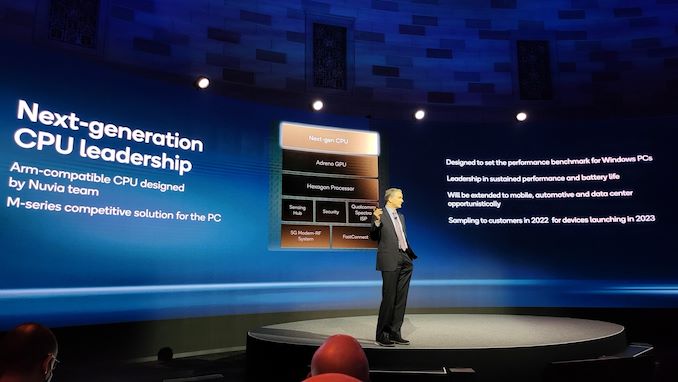
Image from @anshelsag on Twitter, Used with permission
With a lot of hype about Nuvia and the credentials of the team behind it (I apologize, I’m probably responsible for an amount of that hype), we are in this sort of limbo state waiting for the fruits of that acquisition to come through. The 8cx Gen 3 will be a good platform showing an uptick in performance and leveraging 64-bit emulation on Windows 11, but the expectation is that Nuvia’s core design will amplify that performance up another step. Exactly where it will fit compared to Intel or Apple is really hard to say at this point, and we’re going to have to wait to next year. Which makes recommending an 8cx Gen 3 platform in 2022 difficult given that on every review, we’ll have to write a caveat of ‘watch out for the Nuvia designs coming 2023’.


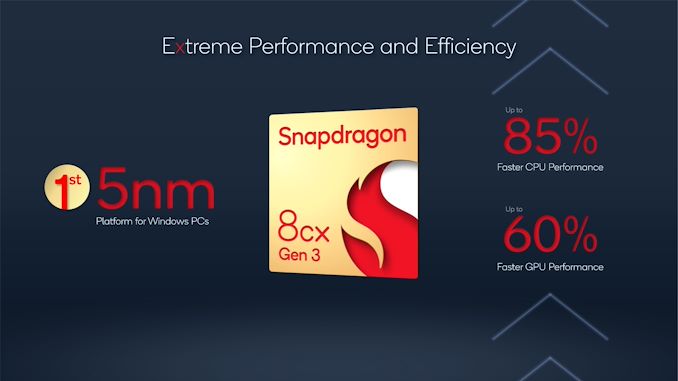
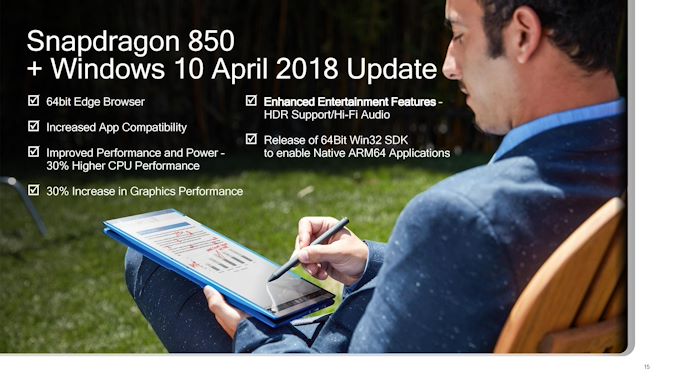

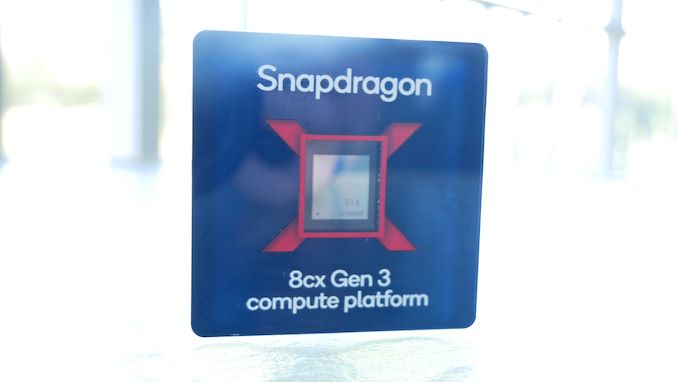

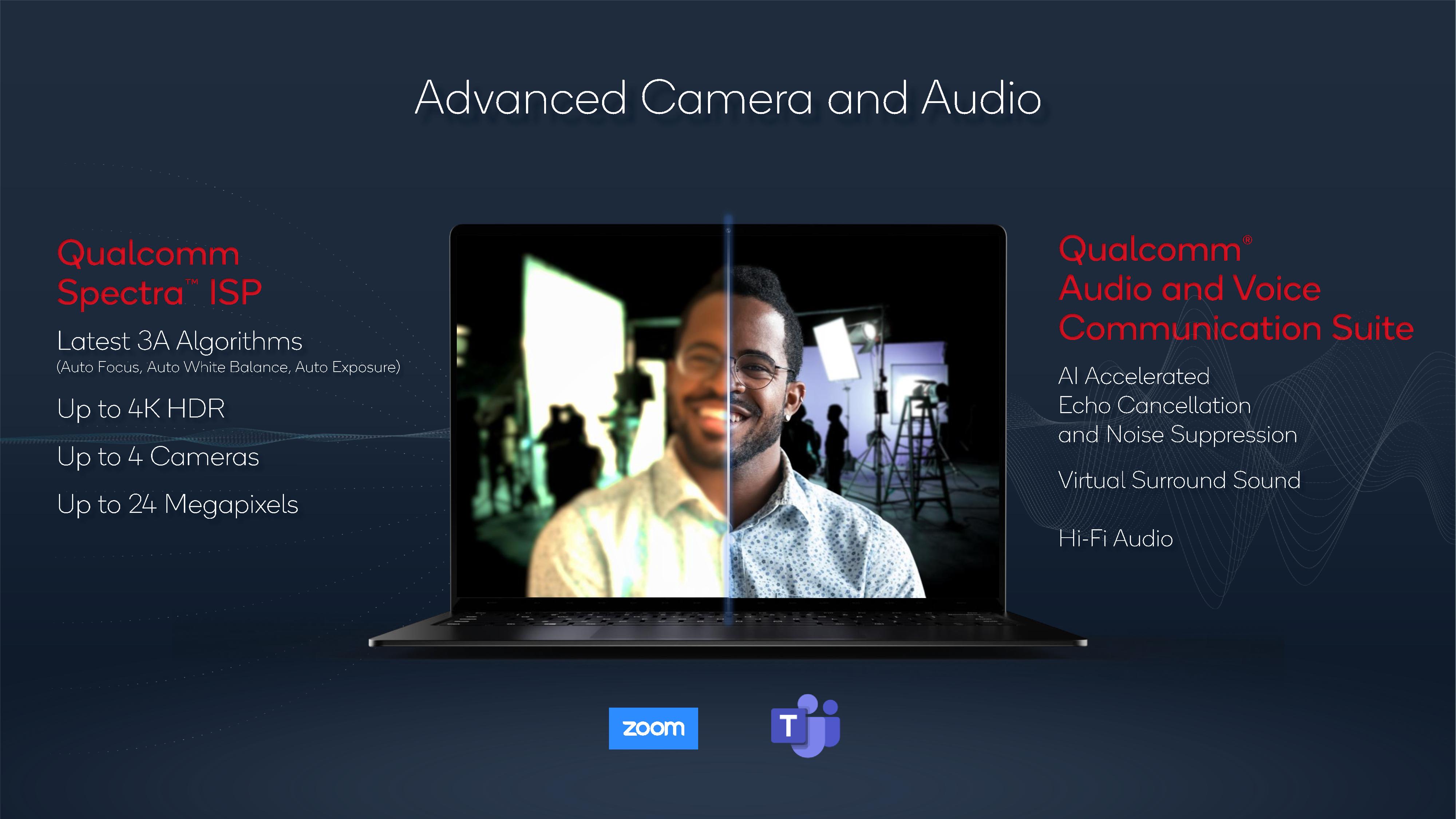








39 Comments
View All Comments
ikjadoon - Wednesday, December 22, 2021 - link
Small typo in the SoC chart. The 8cx Gen 3 is accidentally listed with A55 efficiency cores, even though correctly A78 in the body.//
>In speaking with the carriers in the past couple of months, this way of doing things isn’t going to change soon. The attitude I got was that they’re comfortable extracting significant coin from those willing to pay.
To be frank, sounds like Qualcomm's attitude in the modem & IP sphere. Sucks when it happens to you, eh, Qualcomm?
And, unfortunately, I'm not holding my breath for NUVIA cores to be reasonably priced for all their Windows on Arm limitations. Qualcomm ostensibly charges out the nose for ancient WoA silicon: new silicon on a leading-edge node -> probably Apple pricing during its Intel days. Today, you can get an M1 laptop (with ~ADL 1T perf) for $999 MSRP and often $799 on any day ending in -Y.
milkywayer - Wednesday, December 22, 2021 - link
So... it'll reach the Apple M1 level performance/efficiency in about 5 years?On the bright side Qualcomm will be extorting licensing fee from manufacturers stuck in Android eco system regardless of whatever crap it can produce.
ikjadoon - Wednesday, December 22, 2021 - link
I don't see what their performance claims are: anybody can be "competitive" a year away from a launch presentation. M1? M-series? M1 Pro? M1 Max? M1 in a tablet?Hey, we're 15% slower, but we have a modem, so that means it's competitive! — Qualcomm in 2023
And this isn't even the launch presentation (which will be full of unlabelled graphics, anyways). For a company with a weak custom core track record and a painful customized core track record, Qualcomm isn't one to underpromise and overdeliver.
If Qualcomm cared, they wouldn't have neutered the cache on the SD888 for "die savings" or battered phone OEMs in the CDMA years or whose profits are 1/3 from patent licensing (!).
Frenetic Pony - Wednesday, December 22, 2021 - link
"We're focusing on the experience, not the technology" states technology company.You guys aren't Apple, you don't make end products people buy directly, and you don't make hardware so good it makes the competition feel irrelevant in that category. I so much look forward to an emulated experience skipping the newest tech like the X2 or V1 cores for the same price, and judging by it's release window, same performance as non emulated cores where I can guarantee my software will work.
rmfx - Wednesday, December 22, 2021 - link
Everyone made fun of USB for their terribly bad marketing with Gen 1 2 etc, and the genius at Qualcomm dive just into this... So confusing now.Also, the Nuvia cores take forever to come. the so-called revolution was less of a deal than planned or what?
mcu0730 - Thursday, December 30, 2021 - link
What are you talking about? Nuvia just got acquired this year. Do you not understand how lon acquisitions take? Honestly, I am shocked we are seeing production ready Nuvia devices in 2022mcu0730 - Thursday, December 30, 2021 - link
What are you talking about? Nuvia just got acquired this year. Do you not understand how long acquisitions take? Honestly, I am shocked we are seeing production ready Nuvia devices in 2022mode_13h - Monday, January 3, 2022 - link
What's more shocking is how quickly Nuvia developed supposedly-competitive cores from when they were founded, *including* having to re-target them from server to mobile applications. That's what's really behind the timeframe, nothing to do with the acquisition, per se.Silver5urfer - Wednesday, December 22, 2021 - link
Okay I read through it very fast but did capture the essence. So this new ACPC is an always ol system. Basically a nightmare to put it simply. I will address it later. Next ofc this is only Windows 11 another massive block (but it won't matter since normies will buy that junk anyways). Next is their x86 performance claims + the 2023 market (including GPU, CPU and AI)Now to approach this one by one, first of all 5G mmWave is the key for these always connected machines, next I would refuse to own such a product their latest 8G1 SoC is having always ol camera. it's a POS NSA spybox no matter how I look at it. Next is their always on microphonics system this bundled along with Windows spybox is even more dangerous. Add that Pluton to this equation, M$ already does insane level of telemetry they even added them to Windows 7 and 8.1 retroactively through SSU and CU system. Only way to bypass is manually sort the updates and install for Windows 10 that's not an option because only if you can get a DISM based debloated OS with LTS release you can bypass the bloatware and spyware. 21H2 is still a mess in Win10LTS. I cannot and do not want to imagine how horrible Windows 11 is from user privacy standpoint to the OS, the former has TPM lock so many OEM devices will ship with TPM enabled along with Secure Boot, both of them allow Defender to scan the whole BIOS and entire PC. When we have Intel ME, AMD PSP, Qcomm TEE it's all again another blackbox security just like Apple SEP OS on that Secure Enclave processor. No No and Nope. As for Windows 11 it became a messy UX because of the people at helm who want desktop OS to die for this cluttered simplified dumbed down windows OS from Shell32 to Explorer and add the UWP store BS.
Now the next part, the big and major thing. What is the performance of this thing ? Intel ADL P core Golden Coves trash Apple overhyped M1 processors completely leaving them in dust. Next is AMD's Ryzen 3DV will improve even further and rumors are pegging at BGA solution gets TSMC 6nm refresh that is Rembrandt, it will decimate any Apple or any ARM garbage to ash. Also ADL 11400F is so fast that it destroys all 4C8T CPUs. There's no way any ARM processor can keep up with that performance with BGA package and cTDP even with horrible throttling it will kill any ARM processor. Those are 2022 and what is Qcomm dreaming here ? which x86 they are competing against lol, there's 11th gen and crippled AMD BGA Zen Cezzane. Oh the emulation, there's simply no way this ARM processor can keep up. Add the new ARC iGPUs and Ampere, RDNA2.
Finally this is a pure bga castrated product, no user customizations at all. It will be priced at $1000-2500 easily and for that anyone can own a 11th gen BGA or 12th gen BGA product with dGPU that would smash this to ashes. M1 got slaughtered in GPU performance against 3060L lol a crippled garbage quality silicon. This Adreno nonsense has no chance. Also Windows x86 PCs have SSD slots, NVMe slots, Wifi cards (now sadly most will solder) all user serviceable. Batteries are ofc those pesky packs which have limited life with any garbage laptops nowadays except Thinkpad top of the line or the Clevo LGA (sadly this company is leaving DTR scene because normies want thin and light throttling BIOS locked castrated GPU products with RGB). This one will have even more locked down BIOS code. To remind people of what is possible, Clevo machines Z170 got Custom BIOS which allowed them to run Coffeelake processors yeah that's right from 6th gen to 9th gen you can search for P870DM for more info. And also Maxwell to Turing GPUs too due to MXM slot. Meanwhile this garbage will at max live for 1-2 years in the market and get replaced again just like a smartphone. Amazing plan dumb Android OS down, get into the PC and dumb that down too.
All in all, I will wait and see it get slaughtered by x86.
iphonebestgamephone - Wednesday, December 22, 2021 - link
Back to the cave it is huh?